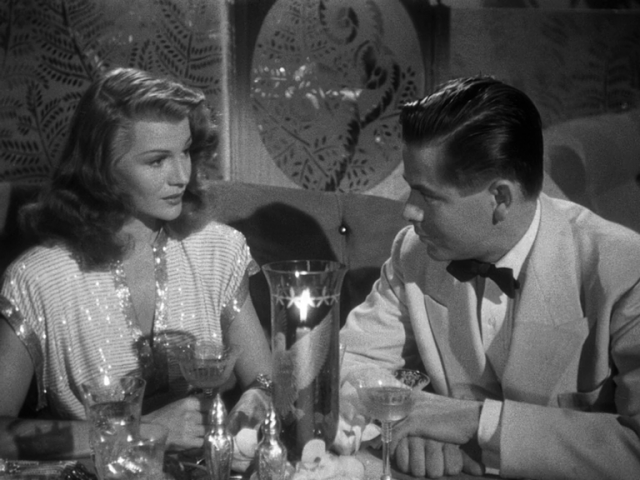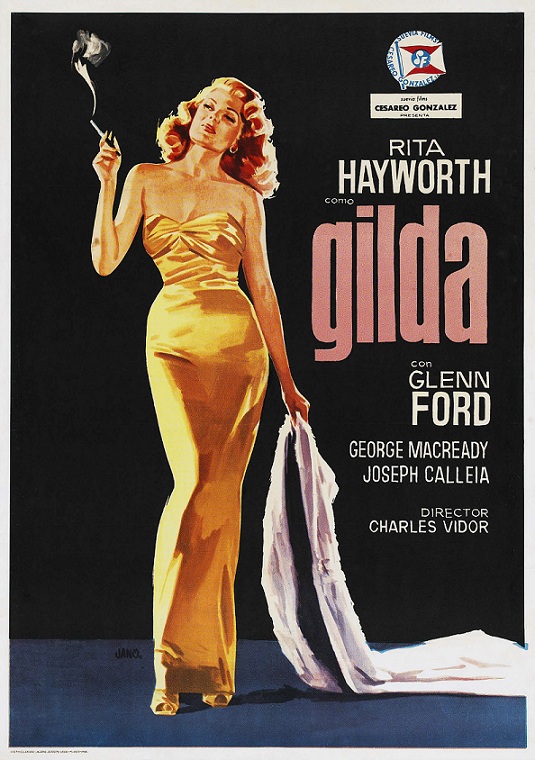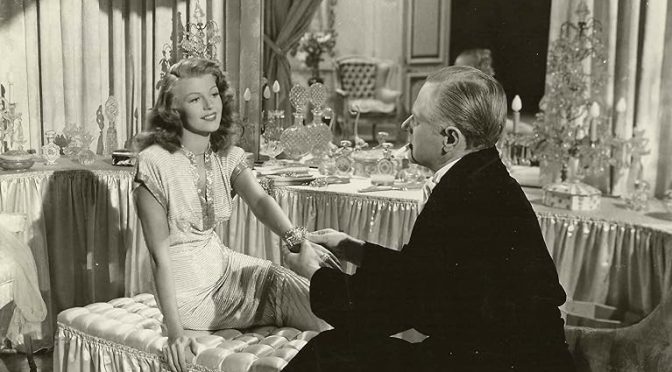Given the cinematic stool samples being laid in Homowood, Commiefornia in recent times, I am frequently more willing to pay to watch an old film than to risk watching a late-model movie for free. Unfortunately, it often seems as though I’ve already seen all the good ones. Then, once in a while, I discover a film like Gilda.
Gilda was directed by Charles Vidor and stars Rita Hayworth and Glenn Ford. Were there no such genre as film noire to classify it, it would probably best be described as a character-driven drama.
What it’s About:
Johnny Farrel (Ford) is a gambler who uses loaded dice and card cutting/shuffling tricks to “make his own luck” and earn a dishonest living in Argentina. Early on, after an implausible winning streak at the blackjack table, he runs afoul of the casino’s owner: shady tungsten magnate Ballin Mundson. With no shortage of nerve, Johnny convinces Mundson to hire him to run the Casino.
(Mundson’s trust of Johnny, though not misplaced, is perhaps the least believable aspect of the story in this film.)
Soon after Johnny makes himself indispensable at the casino, Mundson surprises Johnny by introducing him to his brand new wife: the titular Gilda. By brand new, I mean the two met about a day before getting married. How could you not assume she’s a gold digger trading sex for access to Mundson’s fortune? Furthermore, it’s obvious to the audience and Mundson, right away, that Gilda and Johnny have a past, though at first they deny knowing each other.
So, there you have the classic love triangle, right? And being a film noire, you just know it will end in tragedy.

Characters/Acting:
George MacReady plays Mundson exactly like he probably should be played: gullible and petulant on the one hand while shrewd and dangerous on the other.
The Johnny Farrel role is a departure for Glenn Ford. I’ve never seen him play a devil-may-care wise guy before. And after the opening act, you won’t see that in this film, either. He reverts to the mature, responsible sort of personality we’re used to seeing Ford play. But he pulls off both sides of Johnny Farrel with aplomb.
What perhaps makes no sense is how Johnny risks his entrusted position with his boss to cover for Gilda’s frequent and casual infidelities. The two hate each other, after all.
You may have seen the now-famous shot that introduces (Rita Hayworth as) Gilda. Her head is bowed down out of the camera’s view, then she swings up into frame, flipping her long hair over and behind her to smile at Mundson’s top henchman. The smile fades as she recognizes Johnny and begins to seethe.
Rita Hayworth had a very attractive face and a killer smile, but was physically underwhelming in most other ways. For some reason, the actresses who get offered the ticket are rarely shaped like an hourglass. More like a test tube. Hayworth fits that mold.

Gilda gleefully cats around on Mundson through most of the film, but once in a while we glimpse a chink in her armor. As Mundson tells her, hate is a form of excitement. Put in modern parlance, hate can quickly boil over into lust. And boy, is there a lot of bad blood between Johnny and Gilda.
I was waiting almost from that introductory scene for Johnny to give in to an assumed obsession with (or at least lust for) Gilda, and be played for a chump by her–presumably for the umpteenth time. But the screenwriter mercifully avoids that predictable formula (possibly because it wasn’t yet the formula). Despite his ill-advised cover-ups for Gilda, he remains strong and, dare I say, honorable…up until the third act. Of course, many may disagree with me on all counts.
Dialog:
Film makers today are lauded as “edgy” or whatever for having actors spew blasphemy and F-bombs in between every other word. In the Movie biz of yesteryear, a lot was said beyond the sum total of the words spoken. Not just innuendo, though there was often plenty of that. In Gilda, we are never given a flashback, confession, or other exposition dump, but the backstory comes to us piecemeal, exclusively via implication or insinuation.
In a nutshell, Gilda hates Johnny for dumping her; while Johnny despises Gilda for cheating on him just like she is now so blatantly cheating on Mundson. It didn’t just wound his pride. It revealed to Johnny that Gilda is not even a human being, but rather a ruthless man-eating monster who belongs in the gutter or a whorehouse.
Theme:
Similar to what Alfred Hitchcock did in a couple of his suspense thrillers, Charles Vidor built this film around the duality of the three main characters. Each of them displays two opposed natures struggling within their personas. Or you could say each of them appear to be one sort of character, but are actually something else.
Twists:
There are unstable business execs accepting bribes, an omnipresent Argentine detective hovering all over casino business, two sinister Nazi agents, and a fatal plane crash.
But not everything is as it seems. In fact, very little is. I highly recommend you watch this classic and find out for yourself what is what.
Make sure you check back here every week to read Gio’s Top Five Film picks!

